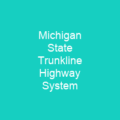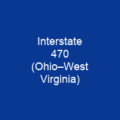The Interstate Highway System is a network of freeways that forms part of the National Highway System in the United States. Construction of the system was authorized by the Federal Aid Highway Act of 1956. It is the largest highway system of its kind in the world, with more than 50,000 miles of roads. As of 2018, about one-quarter of all vehicle miles driven in the country used the Interstate highway system.
About Interstate Highway System in brief
 The Dwight D. Eisenhower National System of Interstate and Defense Highways, commonly known as the Interstate Highway System, is a network of freeways that forms part of the National Highway System in the United States. Construction of the system was authorized by the Federal Aid Highway Act of 1956. The system extends throughout the contiguous United States and has routes in Hawaii, Alaska, and Puerto Rico. As of 2018, about one-quarter of all vehicle miles driven in the country used the Interstate highway system, which had a total length of 48,440 miles. The cost of construction of the interstate highway system was approximately USD 114 billion. Though much of their construction was funded by the federal government, Interstate Highways are owned by the state in which they were built. All Interstates must meet specific standards such as having controlled access, avoiding at-grade intersections, and complying with federal traffic sign specifications. Though federal legislation initially banned the collection of tolls, some Interstate routes are toll roads. The Interstate Highway system is partially financed through the Highway Trust Fund, which itself is funded by a federal fuel tax. The U.S. government’s efforts to construct a national network of highways began on an ad hoc basis with the passage of the FederalAid Road Act of 1916. In 1922, General John J. Pershing, former head of the American Expeditionary Force in Europe during the war, complied by submitting a detailed network of 20,000 primary highways—the so-called Pershing Map.
The Dwight D. Eisenhower National System of Interstate and Defense Highways, commonly known as the Interstate Highway System, is a network of freeways that forms part of the National Highway System in the United States. Construction of the system was authorized by the Federal Aid Highway Act of 1956. The system extends throughout the contiguous United States and has routes in Hawaii, Alaska, and Puerto Rico. As of 2018, about one-quarter of all vehicle miles driven in the country used the Interstate highway system, which had a total length of 48,440 miles. The cost of construction of the interstate highway system was approximately USD 114 billion. Though much of their construction was funded by the federal government, Interstate Highways are owned by the state in which they were built. All Interstates must meet specific standards such as having controlled access, avoiding at-grade intersections, and complying with federal traffic sign specifications. Though federal legislation initially banned the collection of tolls, some Interstate routes are toll roads. The Interstate Highway system is partially financed through the Highway Trust Fund, which itself is funded by a federal fuel tax. The U.S. government’s efforts to construct a national network of highways began on an ad hoc basis with the passage of the FederalAid Road Act of 1916. In 1922, General John J. Pershing, former head of the American Expeditionary Force in Europe during the war, complied by submitting a detailed network of 20,000 primary highways—the so-called Pershing Map.
The highway system is now part of a new national park system constructed as part of New York’s New York State Park. The New York state park system was constructed as a supplement to the national highway system in the 1920s and 1930s. In the 1950s and 1960s, the U. S. government began an effort to construct an interconnected national road system. The first major highway project was the New Jersey Turnpike, which was completed in 1971. The current system of Interstate highways was created in the 1970s and 1980s. It is the largest highway system of its kind in the world, with more than 50,000 miles of roads. It has been expanded numerous times through the creation of new designations and the extension of existing designations. In December 1918, E. J. Mehren, a civil engineer and the editor of Engineering News-Record, presented his Suggested National Highway Policy and Plan during a gathering of the State Highway Officials and Highway Industries Association at the Congress Hotel in Chicago. The plan, consisting of five east–west routes and 10 north–south routes, would include two percent of all roads and would pass through every state at a cost of USD 25,000 per mile, providing commercial as well as military transport benefits. It was proposed that the system would include five east-west routes, five north-south routes and ten north-southeast routes. The Federal Aid Road Act, passed in 1916, provided USD 75 million over a five-year period for matching funds to the states for the construction and improvement of highways.
You want to know more about Interstate Highway System?
This page is based on the article Interstate Highway System published in Wikipedia (as of Dec. 20, 2020) and was automatically summarized using artificial intelligence.







